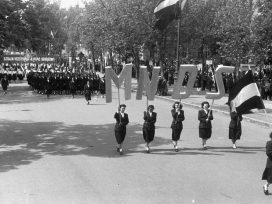A child psychologist friend of mine once related how at one point he suddenly became aware that virtually all his teenage patients were talking about the same film. They would refer to its characters when looking for analogies and likenesses for their dreams, their desires, their internal world or simply their self-image. Since he had not seen the film himself, he decided to go and watch it, so as the better to understand his young patients. The film in question was Star Wars. Since then, maybe only Matrix has approached its impact on this age group (or, for the somewhat younger generation, the book and film versions of the Harry Potter series). It is not hard to spot what it was in these films that was able to exercise such power: a strong mythical world that was able to turn into a communal experience, a parallel universe, an alternative culture – an abiding need that Hollywood picked up on very early and whose satisfaction is largely what drives each and every superproduction.
Not all those involved in these productions are likely to have read what Friedrich Nietzsche has to say in The Birth of Tragedy on the search for myths being the deficiency disease of modernism: “What is indicated by the great historical need of unsatisfied modern culture, clutching about for countless other cultures, with its consuming desire for knowledge, if not the loss of myth, the loss of the mythical home, the mythical womb?” Looking at contemporary culture, those words are possibly more valid than ever. If myths are not readily available locally, then one dips into global myths, which have become localised. If there are no domestic “dragons”, then global “dinosaurs” capture the collective imagination instead. But if local myths do exist (e.g. the issue of national identity), then, in certain historical constellations (e.g. the change to a more democratic regime), they can exercise greater influence, via unscrupulous political manipulation, on the collective imagination than global ones. It is merely a matter of who selects the “dragons” on offer.
American pop culture, it barely needs to be said, was never free from ideological considerations – although today, its globalised variant appears less like an instrument of politics than a machine geared to churning out maximum profit. Still, it does not hurt to recall how certain products of American mass culture (mythical characters and tales) are, for Americans, connected to history in general and to their own history in particular. In a culture constructed on eradicating historical continuity, history had to assume an entirely different form. At the same time, this form needed to coincide with the national self-image that America was seeking to project. For precisely that reason, the New World increasingly tied itself to mythical time planes and natural forces, which not only differed from other (primarily European) cultures, but wherever possible outdid them in size and mythical potential. Especially from the nineteenth century onwards, with the “American Renaissance” (i.e. the consolidation of national identity), America was able to gloss over its colonial nature, proposing and indeed propagating (marketing) itself as a version of the Promised Land. These mythical time planes designated, on one hand, earthly, prehistoric and/or Biblical epochs; on the other, they represented outer-spatial, even post-historic time. All this combined with a national image that appeared in the collective consciousness as Nature’s Nation. This nature, or rather its idealised image, was distinguished from gentrified European natures, in whose “gentle embrace” the poets would saunter, composing their verse. Its size, wildness, beauty and awesomeness intimated a sublime image that European nature could never hope to achieve, let alone surpass.
It is no accident that the consolidation of America’s national identity and the growth of its role as a Great Power coincided with the ascent of American popular culture, which proved to be a versatile and remarkably communicable vehicle of the national self-self-image. Anyone wishing to understand the phenomenon of dinosaur mania (or “dinomania”), an American worldwide export, needs to seek its origins in this context. The lack of local archaeological sites meant that by the end of the nineteenth century, interest in classical archaeology was gradually being overtaken by an interest in palaeontology, which perfectly combined American nature-mania with an unquenchable enthusiasm for technical and scientific discoveries (see the mega-exhibitions of dinosaurs as a form of popular science and pop culture of the time). The dinosaur not only acted as a substitute for a missing, legitimating myth of origin; it also became a symbol of power, subject to mutation – taking, for example, the form of buildings (the Empire State Building or the recently toppled, intensely symbolic monster of the Twin Towers).
In the latter half of the twentieth century, all this was amalgamated with a newly ascendant branch of pop culture: Hollywood. Powerful films ensued whose subject matter and figures lent themselves to global export: more recent examples include Jurassic Park or Star Wars, with their transposition of myth to a utopian future, though one might mention King Kong, that 1933 icon of pop culture, whose gorilla protagonist finds himself (not by chance) on the top of the Empire State Building, having come from an island where (also not by chance) dinosaurs still roam. Dinosaurs, notes Svetlana Boym, became the American unicorns, though better: not only does the fact of their extinction guarantee their mythical character, they are also irrefutably real (scientifically authentic) and universal, hence eminently exportable and marketable. Dinos animated by computer technology reanimate America’s ambitions to be a Great Power – even if these are to be understood “merely” on the cultural plane.
At issue here (hence the use of quotation marks) is precisely the fact that American power politics clearly recognised, before it was too late, the inestimable significance – in other words: power – of this cultural plane both internally as well as abroad (“soft power”). If generations born since 1968 lack a collective historical identity based on shared memories and experiences, then it follows they are going to consume the collective memory (i.e. culture) on offer. The teller of the tale has the power. This – only seemingly simple – formula was something that people came to realise at a time when, throughout Europe, people of so-called high culture looked down disdainfully from their ivory towers on the importance and vigour of popular culture (in many places, including Hungary, they still do). The central question is therefore who attains the position of being able to manufacture and to consume this collective memory substitute.
In the absence of a fundamental, common set of memories and experiences of definitive significance (a “mythical home”, in other words), or an ideology capable of making up for that, a vacuum arises in the lives of the younger generations. Under the worst possible historical constellations, this vacuum becomes capable of sucking in youngsters who do not possess the requisite knowledge and information – and hence defences. Looking around in Hungary today, this is plainly not a spectre borrowed from a sci-fi story. Lacking authentic experiences of their own, they look around for substitutes. A youngster will turn to anything that palliates their feeling of want, and if nothing else is at hand, then drugs or alcohol or aggression will do. I remember well my secondary school days during the hopelessly dreary and empty Seventies, when I thought (in secret, of course, and feeling rather ashamed) that even the vilification undergone by the Jews during the war was better than that grey void. In fact, I felt that if one day a Gestapo officer had strolled into the classroom, got us Jewish pupils up from our benches and taken us away – at least something would have been happening. More than that, a bit of history at last: I could at least be part of a shared history (though that is something I am adding now, in retrospect). I almost envied those members of my family who had received substantial dollops of that…
One has to imagine the degree of resentment (even if subconscious) that prompted me to such seriously muddled thoughts. Thanks to previous generations, with their careful deletion of memory after the war, and to a whole series of taboo subjects, there was nothing by way of mental culture that one could hang on to. Like a tree in crumbly soil with nowhere to find purchase, we constantly sent out roots into the air in search of sustenance. Yet Hungary in the Seventies offered no balm for this sickness (not even the adventures of the multinational crew of the Spaceship Orion, with Major Cliff McLane at their head, and the intrepid Lt Tamara Jagellovsk of the Galactic Secret Service). Only later, as a university student, did I find alternative cultural and political ideas that at last relieved my catatonia.
A comparison of the socialisation and sociology of post-’68 generations of Americans with their eastern European counterparts obviously reveals major differences. Common to both, however, is that, confronted with a lack of definitive, shared memories and experiences, substitutes were needed in order to obtain some kind of shared language and culture. This is particularly true for the generation for whom even Hungary’s switch to democracy in 1989-90 failed to signify a common experience of catharsis, since it had precious little against which to compare the new system. In place of an absent, shared reality and a missing, shared past, people consume substitute realties and substitute memories. The more these substitute pasts resemble genuine reality and genuine memories, the more successful they are. In the cult for retro films, most young people sense only a vague past tense behind which there is no real experience or knowledge, indeed no substance at all, but which is supposed to plug the gap. One might also mention films like James Cameron’s 2009 picture Avatar, which was released not just in the traditional 2-D format but also in 3-D and even “4-D”, or the innumerable computer games that, with the aid of increasingly sophisticated film and computer technologies, are coming ever-closer to reality, to the point where they will presumably actually meet it.
This global popular-culture language (form of communication), formerly propagated primarily by the American entertainment industry, has by now been mastered everywhere. However its essence, its potential, has not been fully understood, which is why it is considered to be just an entertainment industry and not a major, culture-shaping, cohesive force. Moreover, of course, the material resources necessary to produce overwhelmingly affective popular cultural products are not available everywhere. Perhaps even more importantly, not everywhere has popular culture created a uniform, national identity that exists alongside a high culture, as was the case in America. In Hungary, the failure after the regime-change to confront the common past has meant that a strong, unified national and cultural identity was unable to arise. One of the – far from negligible – consequences (as well as of the Kádár regime’s breaking-up of mass culture) was that the unifying, culture-shaping potential of popular culture failed to emerge. Recently, the newly resurgent and energetic rightwing – or, to be more accurate, rightwing extremist – political formations have begun harnessing this potential, with spectacular results.
The upshot is that many people are bewildered and disheartened by the fact that the far-Right has been able to capture a growing numbers of youngsters of university age with populist and exclusionary slogans – and, most recently, with murderous right-wing extremist practices. It counts as a sociological commonplace that, unlike earlier rightwing extremist movements, which mainly mobilised an older, often pension-aged generation, the newer manifestations tend to pick their (unsuspecting) “victims” from the youth – often of so-called “good” families of higher income – who have far from limited access to intellectual sources of information. “How did this happen? What’s going on here?” we bleat, often failing to see the answers that are in plain view.
***
It is a regrettable fact that a political culture has failed to emerge in Hungary since the regime change. Instead, politics has become degraded into a showy popular culture. The Right, so it seems, has been quicker in drawing conclusions and learned how best to turn them to its own advantage. It understood very soon two things that the Left either failed to understand, or was incapable of capitalising on: that in a consumer society, the young want to consume (including products, whatever they are, that substitute for collective consciousness). Its second realisation was that the medium best suited for consumption (and for making people consume) is popular culture, and that the one who uses it best will sooner or later be the winner. If popular culture had not been sidelined (and here I am speaking of the responsibility of leftist governments in power after the political transition), if it had not been looked down on as somewhat embarrassing but tolerable kitsch, useful at best for mega-concerts, big budget film productions, anniversary celebrations and, intermittently, direct propaganda, if it had been recognised that popular culture is an important force for cohesion and communication, then, instead of being horrified at how radical, racist, revisionist and aggressive movements have popped out of the woodwork, there may now have been an alternative to the energetic and canny pop culture of the far-Right. Maybe then the Left would not stand around bewildered by the fact that intelligent young people are capable of jumping on symbols so threadbare and anachronistic as the Árpád coat of arms (which used to be on the country’s flag before 1686), the map of Greater Hungary prior to the 1920 Treaty of Trianon, and the Turul, that bird of prey of not particularly pleasing appearance that has long played such an important part in the myth of origin of the Magyars.
Perhaps, though, that is the key. These symbols deny the present in a way that bears so little regard to the European realities of twenty-first century Hungary that, for young people, they are perfectly suited to representing and modelling a mythical world. For them, the Turul is just as marketable a pop-cultural phenomenon as the dinosaur in America, but with the advantage that it is (supposedly) Magyar. The Turul is the Hungarian “dino” – not global, not exportable, and rather ugly, but at least Hungary’s own. Of course, beauty and ugliness are in the eyes of the beholder: the aggressiveness that makes the Turul so repellent to some may constitute precisely it attraction to the young (see the posthumous international success of the no less ugly and belligerent velociraptors). The Turul represents a kind of strength, authority and collectivity that fills a gap, regardless (unfortunately) of what it can be linked to historically. It is not the actual past that counts but the mythical content invested in it, and the extent to which the symbol in question (in this case the Turul bird) is capable of conveying, or indeed inspiring (reanimating), that content in a dramatic fashion (using the word in its theatrical sense). It is not by chance that the Turul is usually preferred to the map of Greater Hungary – a map, after all, is unable to change characters or roles, and myths require role-players (Hollywood has always been quite clear about that, if nothing else).
Obviously, the mere consumption of material goods cannot fill the vacuum that arises from a lack of culture-shaping communal experiences, “myths” and a “mythical womb”. My use of the term “lack” rather than “loss” is no accident, since the younger generations of today never had that thing which creates the lack, or the sense of lack. In the absence of experiences and memories of a collective historical dimension, the adroit spin-doctors who alight on political pop culture toss out onto the market substitute traumas and substitute memories, which can be consumed without even minimal reflection. If there is no longer even any awareness of a missing object, then one has to be fabricated. This accounts for the incredible success of Trianon nostalgia and the cult of Greater Hungary (this time among the young), which have made their appearance in the guise of a mythical womb, shorn of its lost original content.
It is not the original content that is consumed by young people (for the most part they are ignorant of that), but its substitute function; or rather, they consume the particular function that, together with its artefacts, is released onto the market. “Emblems, along with hieroglyphs, pictograms and symbols, are images that traditionally are considered to be the most polluted by language. An emblem in practice is a compound visual and verbal figure, an allegorical picture provided with a textual explanation,” writes W.J.T. Mitchell. In mentioning “pollution”, Mitchell means that emblems do not speak for themselves; somebody (a culture, or a subgroup within it) is always speaking for them, somebody manufactures the “textual explanations” that go with them – only it is not irrelevant who that is and for what purpose. Due to the failure in Hungary to fully reappraise the past, it is not only the well of history which is unfathomable, but also ignorance, and that puts the young, above all, in a intolerably vulnerable position. These are individuals who, in the absence of personal experiences and collective memories, are consumers of the collective memory offered to or manufactured for them – including the politics degraded to spectacle and transported via the media.
What has happened, it seems, is that instead of Hungarian culture taking advantage of popular cultures’ ability to construct identity, extremists have smashed their noisy way into the groves of high culture. That, at any rate, is what came to mind when I saw a picture (sent by a friend), taken with a mobile phone: a motorcyclist whose black leather jacket was adorned with a map of Greater Hungary, and the slogan: “Don’t bug us you fateless punks” Then it also occurred to me that this must be the all too real, present-tense, mental “Trianon”.






